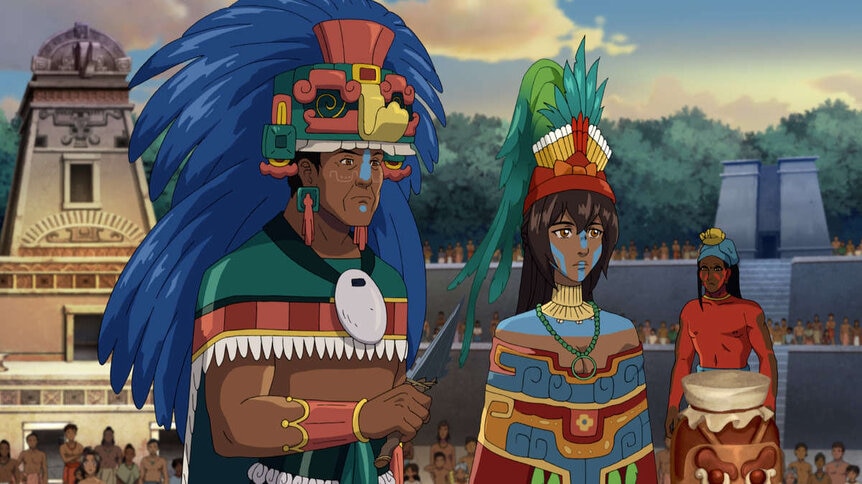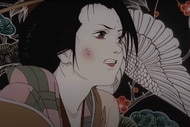Create a free profile to get unlimited access to exclusive videos, sweepstakes, and more!
Onyx Equinox changes what you think of Aztec mythology and Mesoamerican culture by making it anime

Hollywood productions have long portrayed Aztec and Mesoamerican cultures very differently than, say, Greek or Roman ones. More often than not they are reduced to one of two things: either a desolated, mystical place deep in the jungle and filled with treasure, or a savage and bloody civilization whose only pastime is to cut people open and take out their still-beating hearts as sacrifices to the gods. Thankfully, the new anime-inspired show Onyx Equinox tries to change all that.
The show, which is streaming on Crunchyroll, is about a young boy named Izel who is chosen to be humanity's champion in the upcoming war between gods, after the god of the dead, Mictlantecuhtli, raises arms against the other gods and steals their blood sacrifices. While some of the visuals may seem familiar to those who only know these rich cultures from Hollywood tropes — like the show's opening scene, in which a priest slits his own throat as an offer to the gods to save the town from the monsters — Onyx Equinox offers a much more nuanced, layered depiction.
Show creator Sofia Alexander knows that most people watching the show will be familiar with depictions of Aztecs doing blood sacrifices and holding still-beating hearts up in the sky like in Apocalypto, and the show doesn't shy away from the sacrifices, but it does show them in a different light. "We definitely didn't want to use it for shock factor," Alexander tells SYFY WIRE. "When we do show someone slicing their own throat, it's very violent, yes. But we're showing someone giving up his own life for his people. It's in the name, 'sacrifice.' It's not that different from me growing up Catholic and being taught that sacrificing yourself is the ultimate act of love and the most wonderful thing."
It's not only showing the sacrifices as more than savagery, but also the way Onyx Equinox makes them an integral part of its world and its plot to give it an added layer of nuance. The inciting incident starts out from a conflict over which god gets the blood sacrifices from the other gods — sparking a total war. From what we actually know of the Aztecs, the sacrifices were an essential part of their religion and the way they viewed the universe. As Alexander tells it, it's more than just offering blood in exchange for favors like in Greek myths, but is instead a debt to be paid in order to make the world continue. In the show, we see different types of sacrifices, varying in intensity from slitting your own throat to simply a little cut on your finger and having blood droplets on a parchment.
"Sacrifice is literally what makes the sun rise and set," Alexander explains, alluding to the belief that Aztecs offered their own blood because the sun god Huitzilopochtli needed it for nourishment to battle the darkness and ensure the sun would keep rising. "Most of the sacrifices that had a lot of symbolism to them were actually done by the nobles."
A big task for the show is introducing this mythology and culture to an audience that is, for the most part, unfamiliar with it. The secret ingredient seems to be anime. While a war between gods brews in the background, our main story is about Izel, a kid tasked with closing the gates to the underworld and imprisoning the god of the dead. His is a stereotypical shonen — or young adult — anime story, and that was the key for Alexander, who wanted to take the tropes of the genre and use them to tell a story about "growing up emotionally, mentally, and physically." By focusing on making Izel a good and likable protagonist, Alexander believes the show is capable of translating to everyone, no matter how familiar you are with the subject matter.
"I saw this with confidence as someone who grew up in Mexico consuming American and Japanese cartoons," she says. "A lot of these shows brought their own history and culture with them, but you focused on the character and whether you find them relatable. If you buy the story and the characters triumphing, you don't need to understand everything about the cultural significance of the world, but you might still appreciate it."
A typical part of mythology-based stories is the idea that there have been civilizations before the one we're following. Whether it's Greek mythology stories like Rick Riordan's Percy Jackson series or Assassin's Creed Odyssey including Mycenaean ruins, stories of Atlantis, or even Númenor in Lord of the Rings. For Onyx Equinox, it's the Olmec civilization, which was a real civilization that experts consider to be the cornerstone of Mesoamerican culture, but which we know extremely little about. In the show, the Olmec have anti-god technology that we're teased will aid our hero in his quest, and it serves to ground the civilization in history by adding an even longer backstory of previous civilizations that rose and fell.
While average viewers might have a passing familiarity with the Aztecs or the Maya, the Olmecs aren’t nearly as widely known. Alexander is well aware that she's not only teaching Mesoamerican culture and mythology to outsiders, but even to people in Mexico and Latin America who simply don't learn enough about it. In the first episode, we also travel to the actual, real-life city of Uxmal, which is home to people of different backgrounds even in the world of the show. We see farmers selling corn of different colors, Izel weaves colorful fabrics to make beautiful tapestries, and in the third episode, we see some kids playing a ballgame.
"The borders in these cities and cultures weren't closed, and people could travel and trade with each other," Alexander explains. "People traveled all across Mesoamerica, so we wanted to show that it wasn't just Aztecs, and it wasn't just Maya living here."
This also applies to the actual look of the show and how it had to translate the distinct visual style of Mesoamerican art and the way they depict people and gods. "It made it easier once we added the colors of the time in the buildings and the opening sequence of the show. It's not just rock and dirt,” Alexander says, explaining that the pyramids were colorful in their historical prime, so they recreated those colors for the show. “It was colorful and beautiful.”
Of course, Onyx Equinox isn’t totally historically accurate. As far as we know, the people of Mesoamerica weren’t really ravaged by gods and monsters. Even so, Alexander says they looked to real history and culture when designing these gods, giving them the same visual flair and thematic accuracy as the more mundane aspects of the show.
“Tezcatlipoca is also known as the 'smoking mirror' so we added the obsidian smoke when he breathes, while we added feathers and a sort of serpentine look to the character of Quetzalcoatl — who is the feathered serpent,” Alexander explains. “Of course, we will see the gods in their true forms. When? I don't know, but it's exciting to talk about it."
Stories about ancient Rome and Greek mythology have always been popular, and we've got recent shows like Blood of Zeus and video games like Hades to prove why. When it comes to Mesoamerica, however, the biggest production we've got was Mel Gibson's Apocalypto, which did more damage to people's image of Mesoamerican than anything else. Now, Onyx Equinox is daring to do something different and show a different side of the Aztec culture, one that's still full of action, but is also appropriately complex and diverse.




























